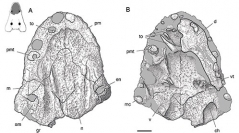

 Comptes Rendus Palevol
12 (7-8) - Pages 463-472
Comptes Rendus Palevol
12 (7-8) - Pages 463-472The Moradi Formation of northern Niger preserves a rare glimpse of tetrapods inhabiting the low paleolatitude regions of Pangea during Late Permian times. In contrast to the broadly distributed and dicynodont-dominated Karoo fauna known from southern Pangea (e.g., South Africa, Tanzania, Zambia, and Malawi), recent work has shown that (1) Moradi tetrapods are endemic, and (2) the taxonomic composition of the Moradi fauna is unlike that of any other Upper Permian fauna. In this contribution, I describe new cranial material of the derived cochleosaurid Nigerpeton ricqlesi. I also compare the Moradi tetrapod assemblage to five other Upper Permian assemblages with bipartite taxon–locality occurrence networks. At the genus level, the Moradi appears unconnected to any other locality, which underscores its endemic nature. In contrast, southern Pangean assemblages display high levels of connectedness and low percentage of endemic genera (except for the Karoo Basin of South Africa, which is likely the result of its more intense sampling). I infer that the fauna of the Moradi Formation was not part of the same faunal province that dominated southern Pangea, but evidence for linking it to the faunal assemblage of the Ikakern Formation of Morocco is currently equivocal.
Niger Republic, Permian, Moradi Formation, Complex network, Biogeography